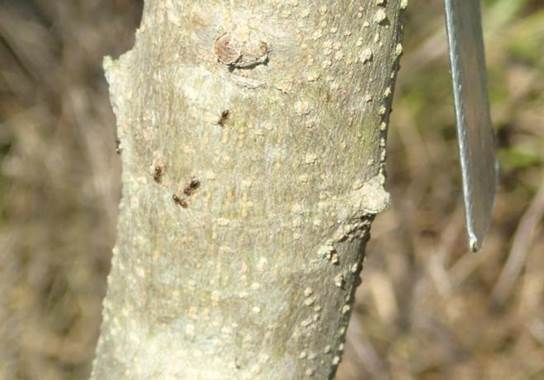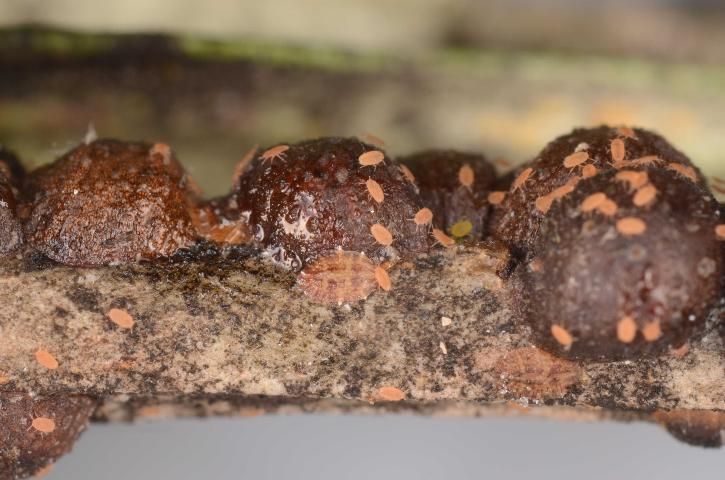Olive (Olea europaea) production in Florida has increased over the last few years. Most of this production is on small farms, but larger areas are being planted as well. As trees become available in nurseries, many homeowners are planting them in their landscapes. Fortunately, olives are a relatively pest-free species, but some occasional invaders can be a nuisance or cause lasting harm. A few plant pathogens that may infect olives also can lead to a decline in overall plant health, fruit yield, or the visual appearance of plants.
Following correct cultural practices when growing olives can reduce your chances of tree loss from pests and diseases. Nearby crops and weeds can build up or harbor potential pests of olives. Research is ongoing to determine what pests from citrus, corn, and solanaceous weeds and crops (e.g., nightshade, tomato, pepper, and eggplant) can move into olive production areas. This information will be helpful for future site selection for olive producers.
This publication is the result of a survey of olive production and interviews with Florida growers in 2014. It has been updated to include all of the pests and diseases described below. Links to more specific pest information on biology, behavior, and control are provided when available.
Occasional Pests
Leaffooted Bugs and Stink Bugs
These true bugs (Order Hemiptera) are known fruit, seed, and vegetable pests in Florida. Olive growers have reported seeing leaffooted bugs (Figure 1) and stink bugs feeding on fruit and causing damage. Management of these pests can be difficult, but if you do not use pesticides for insect management, then natural enemies like parasitic flies and predatory stink bugs can help manage populations.

Credit: Sandra A. Allan, USDA-ARS-CMAVE
Glassy-Winged Sharpshooters
A native pest, the glassy-winged sharpshooter (Homalodisca vitripennis, Figure 2) has been reported by growers as feeding on olive trees in Florida. This pest can vector the plant pathogen Xylella fastidiosa, which causes Pierce's disease of grape. Xylella fastidiosa will cause a rapid decline in olive tree health. This pathogen is known in Florida but has not been isolated from olive trees. Damage on olive trees in Italy first appears with leaves wilting but staying attached to the branch after the leaves brown. If you suspect you have the glassy-winged sharpshooter and damage from Xylella fastidiosa, please contact the authors.

Credit: Lyle J. Buss, UF/IFAS
For more information on this pest, please visit EENY274/IN552. Glassy-Winged Sharpshooter, Homalodisca vitripennis (=coagulata) (Germar) (Insecta: Hemiptera: Cicadellidae: Cicadellinae) by Conklin and Mizell.
Ants can be a sign of a bigger problem in your grove. Ants crawling on tree trunks (Figure 3) and branches can indicate a scale insect problem. If you find ants, you should check the tree for scale insects or signs of scale insects like sooty mold (described below). Although not usually damaging to plants, fire ants can be a nuisance and a danger for workers. Fire ant management can be achieved with several methods described by Collins and Scheffrahn.

Credit: Sandra A. Allan, USDA-ARS-CMAVE
For more information on fire ant management, please visit EENY195/IN352, Red Imported Fire Ant, Solenopsis invicta Buren (Insecta: Hymenoptera: Formicidae: Myrmicinae) by Collins and Scheffrahn, 2001.
Olive Bud Mite
Olive bud mites are not native to Florida, but they have been found on olive trees in several Florida olive-growing areas. Symptoms of olive bud mite presence include leaf curling (Figure 4) and flower or bud drop. Preventing the spread of these pests is very important. As always, do your best to only import and move olive trees that you know are free from pests.

Credit: Paulo R. Reis, EPAMIG Sul de Minas/EcoCentro, Brazil
Defoliators
Grasshoppers and Katydids
Growers have reported minor chewing and defoliation damage from grasshoppers and katydids (Figure 5) on olive trees in Florida. Katydids can also prove a nuisance when they lay eggs in leaf margins (Figure 6). At this time, managing grasshopper and katydid populations can only be achieved by maintaining a weed-free environment in and around groves or by applications of insecticides.

Credit: Sandra A. Allan, USDA-ARS-CMAVE

Credit: Lyle J. Buss, UF/IFAS
For more information on grasshoppers, please visit SP98/IN010, Common Grasshoppers in Florida by Capinera. For more information on katydids and crickets, please visit HS-893, Identification of Insect Pests by Futch, Childers, and McCoy.
Hornworms
Manduca rustica, the rustic sphinx in the family Sphingidae, are commonly referred to as hornworms (Figure 7). These hornworms have been found defoliating olives in Florida. Their damage is apparent when an olive branch appears to be stripped of leaves. If you look below the branch, you will find the frass (excrement, Figure 8) from these caterpillars. Many growers report success with hand removal of these pests.

Credit: Rik Davis, Certified Crop Advisor

Credit: Jennifer L. Gillett-Kaufman, UF/IFAS
For more information on this pest, please visit EENY652/IN1134, Manduca rustica, the Rustic Sphinx by Byron and Gillett.
Olive Shootworm
The olive shootworm, Palpita persimilis (Figure 9), has been found in central and southern Florida on various plants, but it is rarely reported on olive in Florida. The larvae (Figure 10) can cause defoliation of new growth. The larvae tie leaves together with silk to make nests on shoot tips. Feeding damage can be just on the epidermis of the leaf, or as larvae age they will chew holes in leaves. This insect is most commonly found feeding on Japanese privet (Ligustrum japonicum). Please let the authors know if you find this pest in your olive grove. We are trying to map its range distribution in Florida.

Credit: Lyle J. Buss, UF/IFAS

Credit: James E. Hayden, FDACS DPI
For more information on this pest, please visit EENY556/IN995 Olive Shootworm, Palpita persimilis Munroe (Insecta: Lepidoptera: Crambidae) by Hayden and Buss.
Scale Insects
Black Scale
Many scale insects can survive on olives. In Florida, black scale (Saissetia oleae, Figure 11) has been identified from several olive groves. Black scale is also a pest of citrus in Florida, so if you have olives planted near citrus orchards you should be vigilant in monitoring for these pests. As mentioned above, ants can be an indicator of a scale infestation, as can sooty mold (mentioned below). Not all scale infestations require management, but they should be monitored for the presence of parasites. Parasites will leave a distinctive hole in the shell of the scales, as seen in Figure 12.

Credit: Lyle J. Buss, UF/IFAS

Credit: Lyle J. Buss, UF/IFAS
For more information about scale pests you might encounter, please visit EENY 620/IN1082, Black Scale by Byron and Gillett-Kaufman.
Fungi
Sooty Mold
Honeydew (a form of excrement) is produced by aphids, mealybugs, and some scales. Sooty mold (Figure 13) is a fungal organism that lives on honeydew. If you find sooty mold in your orchard, you should look closely for the insects that are producing the honeydew. Sooty mold can reduce the photosynthetic ability of the leaves, but it is not known to invade the plant tissue. If you find sooty mold, you need to manage the insects that are excreting the honeydew; once they have been eliminated, the sooty mold will eventually flake off of the leaves.

Credit: Lyle J. Buss, UF/IFAS
Olive Anthracnose
Fruit damage known as olive anthracnose (Figure 14) is a common problem reported by homeowners with olives in their landscape. Mainly caused by Colletotrichum acutatum, olive anthracnose should not be a major problem for growers, but you should be aware of the problem. Increased presence on flowers and fruit in the grove could warrant application of a fungicide. Olive anthracnose can lead to fruit drop, and fruit drop can lead to a mess in the landscape, especially near impervious surfaces like sidewalks and paved driveways. The damage on the fruit can cause the fruit to be more attractive to insects like fruit flies. Research is underway to determine whether olive anthracnose might lead to damaging levels of fruit fly infestations. Fruit flies are known to lower the quality of oil produced from infested olives.

Credit: Jennifer L. Gillett-Kaufman, UF/IFAS
For more information on managing anthracnose on other crops, please visit https://edis.ifas.ufl.edu/topic_colletotrichum.
Not Here Yet
Olive Fruit Fly
The olive fruit fly, Bactrocera oleae (Figure 15), is a non-native pest of olives that has not been reported in Florida. This is a serious pest of olives in California and Mediterranean olive-producing areas.

Credit: Giancarlo Dess, Istituto Professionale Statale per l'Agricoltura e l'Ambiente "Cettolini" di Cagliari
For more information on this pest please visit EENY113/IN270, Olive Fruit Fly, Bactrocera oleae (Rossi) (Insecta: Diptera: Tephritidae) by Byron and Gillett-Kaufman.
Olive Psyllid
The olive psyllid (Figure 16) has not been found in Florida, but it does have the potential to spread to new locations via olive tree importation, so growers should be aware of the insect. Olive psyllids produce a white, waxy secretion, which can cause premature flower drop during infestations.

Credit: Marshall W. Johnson, Center for Invasive Species Research, University of California Riverside
Conclusion
If you are producing olives and encounter a pest or disease that is not listed here, please contact your local UF/IFAS Extension office for assistance with identification and management. This sheet will be updated regularly as information becomes available on new olive pests and diseases in Florida. To suggest an addition, please contact the authors.
Acknowledgments
The production of this document would not have been possible without support from numerous producers who shared information and allowed us to collect samples from their trees including, but not limited to, Richard Williams and the Ford Family with Florida Olive Systems, and Jonathan Carter and Stephen Carter with Florida Olive Farms and Mill. Funding for the development and of this document was provided by UF/IFAS. Special thanks to the UF/IFAS Extension Administration team for their support. A 2016 Florida Cooperative Extension Service Professional Development Mini-Grant provided Dr. Gillett-Kaufman with the opportunity to visit olive groves in southern Italy to learn more about olive sudden decline and how that insect pathogen interaction could impact Florida olive production.
References
Byron, M.A. and J. L. Gillett-Kaufman. 2016. Bactrocera oleae. EENY-113. Gainesville: University of Florida Institute of Food and Agricultural Sciences. https://edis.ifas.ufl.edu/in270
Byron, M.A. and J. L. Gillett-Kaufman. 2016. Rustic Sphinx Manduca rustica (Fabricius) (Insecta: Lepidoptera: Sphingidae). EENY-653. Gainesville: University of Florida Institute of Food and Agricultural Sciences. https://edis.ifas.ufl.edu/in1134
Capinera, J. L. 1992. Common grasshoppers in Florida. SP98/IN010. Gainesville: University of Florida Institute of Food and Agricultural Sciences. https://edis.ifas.ufl.edu/in010
Collins, L. and R. H. Scheffrahn. 2001. Red imported fire ant, Solenopsis invicta Buren (Insecta: Hymenoptera: Formicidae: Myrmicinae). EENY195/IN352. Gainesville: University of Florida Institute of Food and Agricultural Sciences. https://edis.ifas.ufl.edu/in352
Conklin, T. and R. F. Mizell. 2002. Glassy-winged sharpshooter, Homalodisca vitripennis (=coagulata) (Germar) (Insecta: Hemiptera: Cicadellidae: Cicadellinae). EENY274/IN552. Gainesville: University of Florida Institute of Food and Agricultural Sciences. https://edis.ifas.ufl.edu/in552
Futch, S. H., C. C. Childers, and C. W. McCoy. 2002. Identification of insect pests. HS-893. Gainesville: University of Florida Institute of Food and Agricultural Sciences. https://edis.ifas.ufl.edu/hs142
Hayden, J. E. and L. J. Buss. 2013. Olive shootworm, Palpita persimilis Munroe (Insecta: Lepidoptera: Crambidae). EENY556/IN995. Gainesville: University of Florida Institute of Food and Agricultural Sciences. https://edis.ifas.ufl.edu/in995
Linn, S. and J. L. Gillett-Kaufman. 2016. Oxycenus maxwelli (Keifer, 1939) (Arachnida: Acari: Eriophyidae). EENY-651. Gainesville: University of Florida Institute of Food and Agricultural Sciences. (No longer available online.)
Linn, S. and J. L. Gillett-Kaufman. 2016. Olive olive psyllid (suggested common name), Euphyllura olivina (Costa 1839) (Hemiptera: Psyllidae). EENY-656. Gainesville: University of Florida Institute of Food and Agricultural Sciences. (No longer available online.)